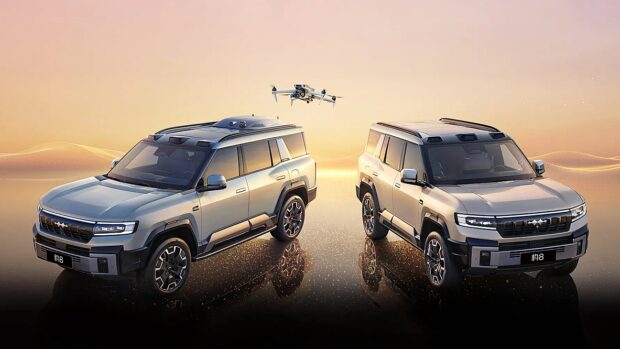EV maker BYD unveiled ‘Lingyuan,’ a vehicle-mounted drone launching system developed in collaboration with DJI that is available for all of the company’s vehicles, reports Chinese state media outlet Xinhua. The system is only available in China, like BYD’s vehicles, and costs 16,000 yuan (or about $2,197).
BYD’s video below, reposted by YouTube channel ShanghaiEye, has some real science fiction vibes: the driver taps a button on their vehicle’s touch screen, and doors slide open on the top of the car, revealing a rising landing platform with a drone on it. The drone is shown lifting off while the EV is in motion in some shots, then following the car down the road.
The drones can take off and land “at speeds up to 25 km/h” and that they can return automatically as long as they’re within two kilometers of the vehicle. The story also says the drone can follow at up to 54 kilometers per hour. The hangar charges the drone when it’s docked.
The Lingyuan purchase price includes a DJI drone — reports don’t seem to say which, but the video shows a DJI Air 3S — as well as the roof-mounted drone hangar, and apps that work with the system, according to South China Morning Post. The apps include one for video editing (possibly one of DJI’s existing apps) as well as one for “AI recognition,” whose function isn’t specified by SCMP. Google-translated text from BYD’s demo video revealing the system mentions “AI Posture recognition, Lingyuan takes photos around the car.” It’s not clear whether BYD owners can install the system on a vehicle themselves.
BYD and DJI collaborated in “developing a fully integrated system from the ground up,”
BYD chairman Wang Chuanfu said at a launch event in Chinese tech hub Shenzhen on Sunday, writes SCMP. The automaker also reportedly introduced a version of its Bao 8 SUV that comes “pre-equipped with the Lingyuan system.”
Its hardware includes a drone hangar, a drone, an on-board positioning module handle, and BYD also provided the Ling Yuan App, AI recognition software, and image and music editing software. The drone hangar is 0.29 square meters when the hangar apron is unfolded, and the thickness of the hangar is 21.5 cm.
The system supports dynamic takeoff and landing of drones at speeds up to 25 km/h and automatic return of drones within 2 km. The drone can follow a vehicle at speeds up to 54 km/h. The drone can automatically return to recharge its battery when it is running low, from 20 percent to 80 percent in 30 minutes.
The Ling Yuan system will be available to all brands under the BYD umbrella and is priced at RMB 16,000 ($2,200).
The first models that support the system include the Yangwang U8, Fang Cheng Bao Bao 8, Fang Cheng Bao Tai 3, Denza N9, BYD Sealion 07 DM-i, and BYD Tang L.
Clearly it’s an absolute safety nightmare that probably wouldn’t get regulatory permission anywhere in the world beyond some spots in China.
In addition it doesn’t improve the car’s looks, adding a large bump on the rear of an SUV’s roof.
Another thought: this clearly has military implications. Russian’s invasion and ongoing war against Ukraine has taught us that drones are essential elements of modern warfare, and being able to launch them on-the-go from vehicles is easily foreseeable as part of the future of combat.
Sources: CNEVPOST; The Verge; Forbes;



